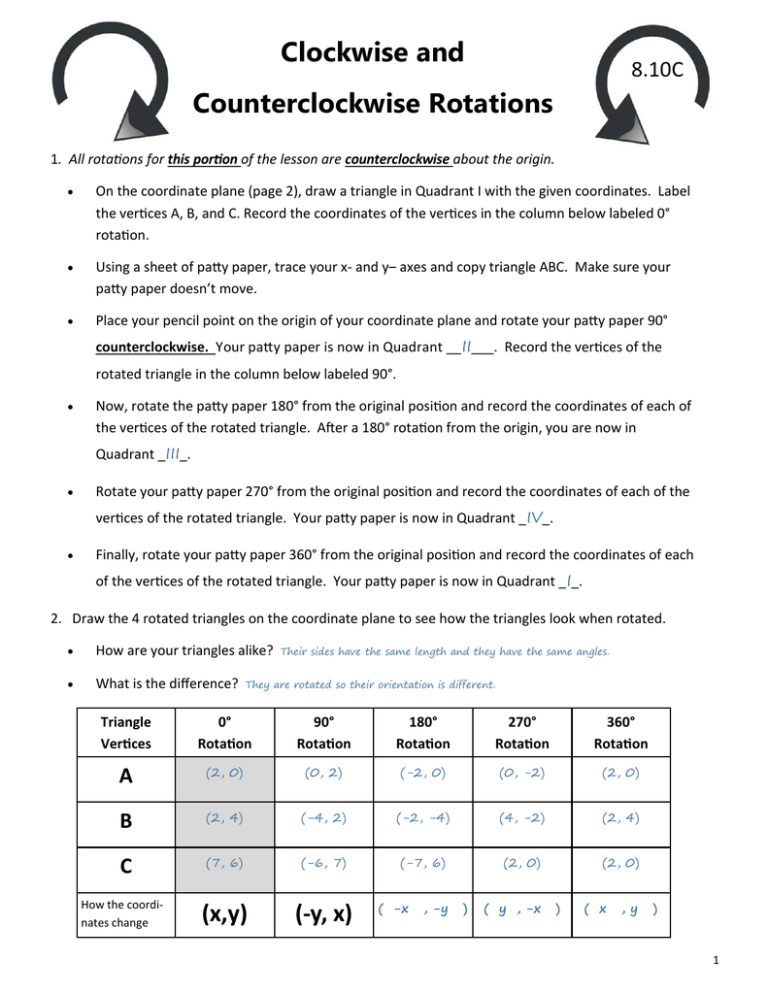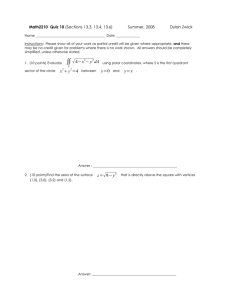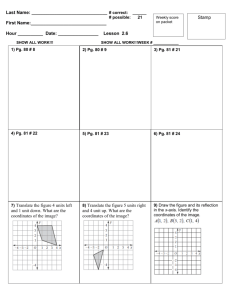Clockwise and Counterclockwise Rotations
advertisement

Clockwise and 8.10C Counterclockwise Rotations 1. All rotations for this portion of the lesson are counterclockwise about the origin. On the coordinate plane (page 2), draw a triangle in Quadrant I with the given coordinates. Label the vertices A, B, and C. Record the coordinates of the vertices in the column below labeled 0° rotation. Using a sheet of patty paper, trace your x- and y– axes and copy triangle ABC. Make sure your patty paper doesn’t move. Place your pencil point on the origin of your coordinate plane and rotate your patty paper 90° counterclockwise. Your patty paper is now in Quadrant __II___. Record the vertices of the rotated triangle in the column below labeled 90°. Now, rotate the patty paper 180° from the original position and record the coordinates of each of the vertices of the rotated triangle. After a 180° rotation from the origin, you are now in Quadrant _III_. Rotate your patty paper 270° from the original position and record the coordinates of each of the vertices of the rotated triangle. Your patty paper is now in Quadrant _IV_. Finally, rotate your patty paper 360° from the original position and record the coordinates of each of the vertices of the rotated triangle. Your patty paper is now in Quadrant _I_. 2. Draw the 4 rotated triangles on the coordinate plane to see how the triangles look when rotated. How are your triangles alike? What is the difference? Their sides have the same length and they have the same angles. They are rotated so their orientation is different. Triangle Vertices 0° Rotation 90° Rotation 180° Rotation 270° Rotation 360° Rotation A (2, 0) (0, 2) (-2, 0) (0, -2) (2, 0) B (2, 4) (-4, 2) (-2, -4) (4, -2) (2, 4) C (7, 6) (-6, 7) (-7, 6) (2, 0) (2, 0) (x,y) (-y, x) How the coordinates change ( -x , -y ) ( y , -x ) ( x ,y ) 1 Coordinate Plane Label and connect these vertices to form a triangle: A(2,0) B(2,4) C(7,6) Quadrant II C Quadrant I B A Quadrant III Quadrant IV 2 2 Rotate 180° 1 Rotate 90° 3 Rotate 270° Draw each rotation. Assume the rotations are counterclockwise about the origin. 1—Rotate 90° 2—Rotate 180° Some coordinates in original figure. Some coordinates in original figure. ( 0 , 4 ) ( 1,1 ) ( 2,0 ) (1 , 1 ) (4 , 2 3—Rotate 270° )(1 ,3 Some coordinates in original figure. (1 ) , -3 ) (3 , -4 )(4 ,0 ) Corresponding coordinates in image. Corresponding coordinates in image. Corresponding coordinates in image. (-4 , 0 ) (-1 , 1 )(0 , 2 ) (-1 Describe the relationship in words. ,-1 (x,y) (_-y_, __x__) ,-2 ) (-1 ,-3 ) ( Describe the relationship in words. Answers will vary Describe the relationship with symbols. ) (-4 3 , 1 (x,y) (_-x_, __-y__) , 3 )(0 ,4 ) Describe the relationship in words. Answers will vary Describe the relationship with symbols. ) (4 Answers will vary Describe the relationship with symbols. (x,y) (_y_, __-x__) 3 4-Rotate 180° 5-Rotate 270° 6-Rotate 90° Draw each rotation. Assume the rotations are clockwise about the origin. 4—Rotate 180° 5—Rotate 270° Some coordinates in original figure. (2 , 5 ) (0 , 0 )(0 , 2 6—Rotate 90° Some coordinates in original figure. (-5 ) , 1 ) (-3 , 0 ) (-2, 4 Some coordinates in original figure. ) (-2 , -1) (-4 , -3) (-1 ,-3) Corresponding coordinates in image. Corresponding coordinates in image. Corresponding coordinates in image. (-2 , -5) (0 , 0 )(0 , -2 ) (-1 Describe the relationship in words. ,-5 (x,y) (_-x_, __-y__) ,-3 ) (-4 ,-2 ) Describe the relationship in words. Answers will vary Describe the relationship with symbols. ) (0 ( -1 (x,y) (_-y, __x__) ) (-3, 4 ) ( -3, 1 ) Describe the relationship in words. Answers will vary Describe the relationship with symbols. , 2 Answers will vary Describe the relationship with symbols. (x,y) (_y_, __-x__) 4



